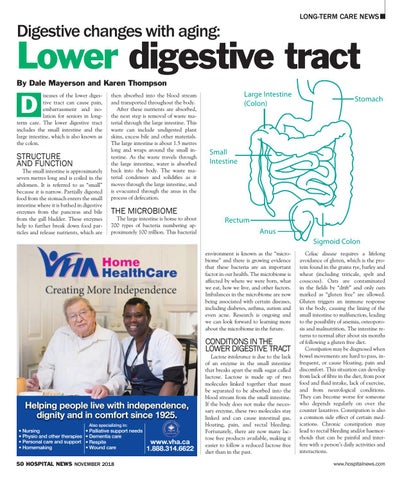LONG-TERM CARE NEWS
Digestive changes with aging:
Lower digestive tract By Dale Mayerson and Karen Thompson iseases of the lower digestive tract can cause pain, embarrassment and isolation for seniors in longterm care. The lower digestive tract includes the small intestine and the large intestine, which is also known as the colon.
D
STRUCTURE AND FUNCTION The small intestine is approximately seven metres long and is coiled in the abdomen. It is referred to as “small” because it is narrow. Partially digested food from the stomach enters the small intestine where it is bathed in digestive enzymes from the pancreas and bile from the gall bladder. These enzymes help to further break down food particles and release nutrients, which are
then absorbed into the blood stream and transported throughout the body. After these nutrients are absorbed, the next step is removal of waste material through the large intestine. This waste can include undigested plant skins, excess bile and other materials. The large intestine is about 1.5 metres long and wraps around the small intestine. As the waste travels through the large intestine, water is absorbed back into the body. The waste material condenses and solidifies as it moves through the large intestine, and is evacuated through the anus in the process of defecation.
THE MICROBIOME The large intestine is home to about 700 types of bacteria numbering approximately 100 trillion. This bacterial
environment is known as the “microbiome” and there is growing evidence that these bacteria are an important factor in our health. The microbiome is affected by where we were born, what we eat, how we live, and other factors. Imbalances in the microbiome are now being associated with certain diseases, including diabetes, asthma, autism and even acne. Research is ongoing and we can look forward to learning more about the microbiome in the future.
CONDITIONS IN THE LOWER DIGESTIVE TRACT
Helping people live with independence, dignity and in comfort since 1925. • Nursing • Physio and other therapies • Personal care and support • Homemaking
Also specializing in:
• Palliative support needs • Dementia care • Respite • Wound care
50 HOSPITAL NEWS NOVEMBER 2018
www.vha.ca 1.888.314.6622
Lactose intolerance is due to the lack of an enzyme in the small intestine that breaks apart the milk sugar called lactose. Lactose is made up of two molecules linked together that must be separated to be absorbed into the blood stream from the small intestine. If the body does not make the necessary enzyme, these two molecules stay linked and can cause intestinal gas, bloating, pain, and rectal bleeding. Fortunately, there are now many lactose free products available, making it easier to follow a reduced lactose free diet than in the past.
Celiac disease requires a lifelong avoidance of gluten, which is the protein found in the grains rye, barley and wheat (including triticale, spelt and couscous). Oats are contaminated in the fields by “drift” and only oats marked as “gluten free” are allowed. Gluten triggers an immune response in the body, causing the lining of the small intestine to malfunction, leading to the possibility of anemia, osteoporosis and malnutrition. The intestine returns to normal after about six months of following a gluten free diet. Constipation may be diagnosed when bowel movements are hard to pass, infrequent, or cause bloating, pain and discomfort. This situation can develop from lack of fibre in the diet, from poor food and fluid intake, lack of exercise, and from neurological conditions. They can become worse for someone who depends regularly on over the counter laxatives. Constipation is also a common side effect of certain medications. Chronic constipation may lead to rectal bleeding and/or haemorrhoids that can be painful and interfere with a person’s daily activities and interactions. www.hospitalnews.com
